The Iris Diaphragm Prospects of repair? By Paul James
|
The Iris Diaphragm Prospects of repair? By Paul James
|
Throughout its potentially long life the Iris Diaphragm is called upon to play its role, then at some time its delicate mechanism fails. Chances are that the onset of failure is noticed as the resistance of the lever suddenly increases denoting some form of seizure, or by the sound of the 'leaves' complaining of strain. Pear drop shape apertures are common too when the diaphragm fails as one or two of its leaves become unresponsive. A well made example will last a couple of lifetimes or more in sensitive hands, and there are examples of diaphragms still winking from as far back as the 1800's! Though in essence the diaphragm is a simple device its manufacture is not so straightforward, as even its reassembly can test the skills and patience of anyone who has tried. Examples of the best diaphragms manufactured show clearly that there is a great deal of quality engineering and design invested in them, and so their usage should be well regarded, particularly by fingers sensitive enough to pause the moment the slightest change in lever resistance is felt.
The Mechanism
Iris Diaphragms ( ID for brevity's sake) come in various forms, differing in materials, design and size. Essentially most employ a number of semi-circular 'leaves' each sporting 2 pins riveted one at either end on opposing sides. Half of these pins engage in holes around the periphery of the body of the ID whilst their opposite numbers are located in short slots milled around the periphery of the 'driver' plate which is under the control of the finger lever. The slots allow for the change in the radial variations the leaf experiences as the ID is closed and opened. It is an ingenious device which has been manufactured by optical/engineering companies in varying guises, but they are all essentially of similar spiral format where rotation of the outer leaves closes the aperture in a smoothly controlled manner.
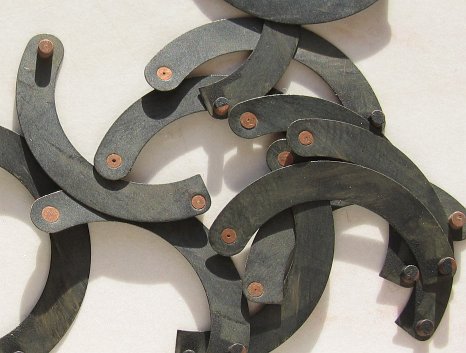 |
Above a typical set of 12 leaves taken from a small ID which is depicted at three times normal size
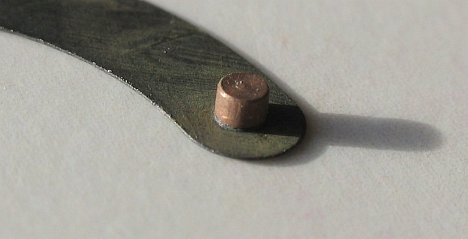 |
Here we see a pin in its place with flush 'peaned' back surface to facilitate smooth and trouble free operation
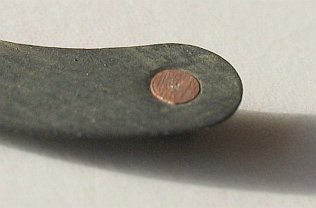 |
Below, the body of the condenser or lens barrel has a number of static holes into which one pin from each leaf registers can be seen.
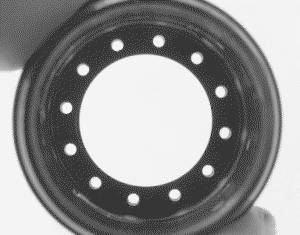 |
2 leaves are shown below resting more or less in their working position on top of the driver plate whose slots allow the constant radial change of position of their respective leaf pins when it is rotated during operation. The upper pins are housed in the holes of the ID body shown above.
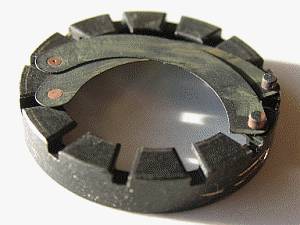 |
One particular feature of substage IDs is their ability to close down almost completely: a facility rarely required in ordinary camera lenses. This needs carefully designing and manufacture because the lever stop needs to coincide precisely with the pinhole setting of the iris, otherwise damage might ensue from the crumpling of the leaves. The image below is of a typical ID where the lever stops positively just before iris closure. Of course an iris in the substage condenser in this state is of little use for brightfield observation, but is provided so that we can align the optical train more easily knowing where the substage central axis is. This expectant feature places some responsibility on microscope manufacturers to produce IDs of high geometric accuracy as well as sound mechanical integrity.
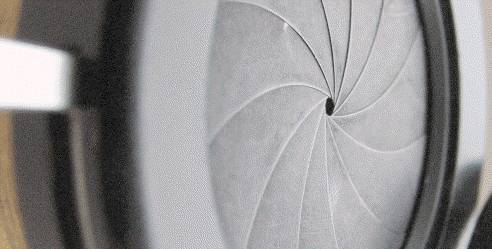 |
So what can go wrong?
If by chance you find that a single leaf is damaged beyond repair, the ID can often still function producing a reasonably circular aperture...........but much depends on the total number of leaves, which can vary from as little as 3 in the very cheap forms to 15 or more as shown in the first image above. 12 leaves is commonly used for the average substage or field condenser.........more leaves produce more geometrically perfect circles.
I think those ID's employing steel leaves give most of the trouble as oxidation causes dust which exacerbates friction which in turn tempts the user to oil them. Then the problem compounds because oil attracts dust which in turn helps to make the oil drier and so ad infinitum! All this just increases the forces necessary to adjust the iris, and of course something fails eventually..............usually the pins or the leaves crumple.
Though an oiled ID might feel smooth in operation to the touch, the chances are that the pins are straining with forces they were not designed to take, as the leaves are not sliding over each other in their oil free original state, but are wrestling with relatively high oily contact forces.
However, the driver's periphery might benefit from a modicum of oiling or appropriate grease.
Steel leaves are used particularly in camera lenses where they are relatively free of moisture and abundant oxygen. Many are coated with various substances to suppress oxidation and perhaps aid slippage, but this process can produce plenty of unwanted fine particles dancing around inside promising future trouble.
Diaphragms in microscopy are usually more accessible to the atmosphere, insects, mould and probing fingers etc., so are more vulnerable to long term chronic damage.
If you are tempted to try repairing an ID for the first time, remember to take notes of the physical disposition of all the parts and mark the internal bores if necessary to record positions etc. Best open the iris fully and make marks wherever suitable to make sure when reassembling the driver plate that it goes back precisely in original position relating to the lever and its body stop. Even a few digicam snaps will help.
Repair?
Once an ID's mechanism is over strained its future is very likely to be very short or non-existent. Repairing an iris diaphragm from a long owned and intrinsically valuable instrument depends very much on the specific problem of course, but it can be a very tedious, as well as a difficult and time consuming process. I suspect a few damaged diaphragms are consigned to the scrap heap, which then invites the problem arising from the process of replacement.
However, I have effected some repairs and adjustments to some diaphragm assembles and in particular I had to repair a very good CTS ID with steel leaves which had been neglected, as I'd found a couple of its leaf pins had loosened. Using the low power stereo 'scope was necessary to re-rivet these back onto the leaves which was very fiddly indeed. Unfortunately as I did this a long time ago I have no photographic record of the way I repaired them......but from memory:-
"The pins were held firmly by pushing them into holes made by tapping in an appropriate panel pin or similar into a piece of scrap wood which is long enough for both hands to rest on to keep firm OR of course held in a vice:-
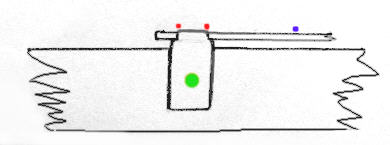 |
Once the pin was in a fixed position with the rebate uppermost the leaf could be positioned back over it to allow the spigot through the hole of the leaf. Careful peaning over the soft bronze with a sharp instrument reattached the pin once more, and the repair was made as smooth as possible to prevent seizure. The finished job was not tidy under the eyeglass but that didn't matter as it worked well and still does."
Other problems besetting the ID are crumpled or distorted leaves which have got that way because of inherent friction from dried up lubricant or insensitive use after a pin or two loosened. Sadly once a leaf has been crinkled its life is essentially over and that of the ID as a whole unless you can flatten it very carefully and also replace the pin...........a task only the really dedicated embrace! Slide mounters and clock makers have a decided advantage!!
Leaf reassembly etc.
Depending entirely on the physical aspects of the ID makes for either difficult or relatively easier implementation of the repair. Of course if you find yourself having to re assemble it all then each leaf must be orientated so the pins are housed in their appropriate hole in the body of the ID. The leaves are layered one at a time around the inside of the body each overlapping the previously laid leaf. The great difficulty occurs when the last few are placed in situ simply because some of the those already in place need to be raised slightly for the final fitment of the remainder.......as you will experience. THIS can be very problematic with small deeply housed iris diaphragms as the process tends to loosen the rest of the leaves. I have 2 solutions which work 1) If you have steel leaves then use a magnet beneath the ID to retain the leaves securely as you go along OR 2) If your leaves are bronze/brass then coat every leaf including the platform with the holes with something sticky such as 'Vaseline which will prevent the leaves from springing about whilst laying them into place. Once the whole job is completed, the sticking agent can be dissolved away with appropriate solvent.
Putting the driver plate back
Pushing home the driver plate is relatively straightforward and just requires sensitive observation so that all the pins ready to receive the slots are equally spaced from each other. Always push the leaves out to maximum opening so their upper pins are all evenly spaced to receive the driver plate. When the plate is eased over the pins, its retaining ring should be gently screwed down on the driver plate which should be slowly oscillated whilst the retaining ring is finally brought to its working position. A registration mark denoting the in-place position of both the ID barrel and this retaining ring gives reassurance that everything is back to original position.............a very important point.
If you used Vaseline or similar to aid the reassembly of the leaves this needs removing using petroleum based solvents, though iso-butyl alcohol will shift the bulk of it.
The success of a repair depends not just on the sensitive skills of the hands BUT as much on the accuracy of the notes and sketches you make before disassembly. Hopefully your particular repair will be easier than those I have described as most substage iris assembles seem to be fairly accessible. Good luck!
| All comments welcome by the author Paul James |
Microscopy
UK Front Page
Micscape
Magazine
Article
Library
Please report any Web problems or offer general comments to the Micscape Editor.
Micscape is the on-line monthly magazine of the Microscopy
UK web
site at Microscopy-UK